In a given year, the NHL Draft is not an exact science. Players will rise and fall and the real results of a draft can’t truly be known for upwards of five seasons.
This season, the idea of the draft itself is mired in questions. When will the draft be? Where will it be? When is the lottery? What happens to conditional picks?
Once all of these things are ironed out, the Buffalo Sabres will find themselves in an all too familiar position. For the eighth season in a row, they will be the proud (?) owners of a top-10 pick.
Related: Sabres Goalie Rocky Farr Recalls Memories From Early Buffalo Teams
Premium draft picks are a hot commodity in today’s NHL. With a hard salary cap, it becomes increasingly difficult to build a long-term winner that can stay together. When you can add a constant flow of youthful skill into your organization on the cheap, common sense says you should do it.
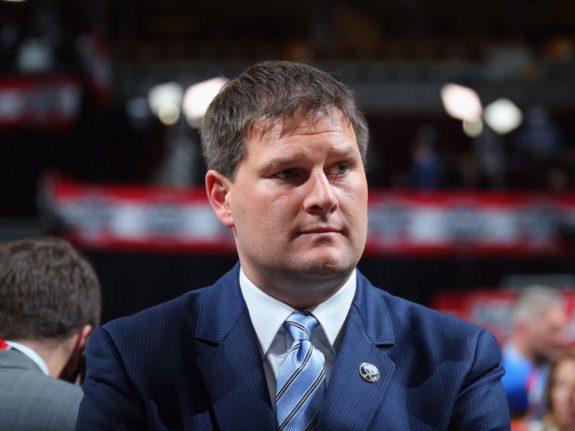
The Sabres have had the privilege of picking high so often because of how terrible they have been the last decade or so. They are top-heavy talent-wise and do not boast a great depth of prospects on the way to bolster their squad. That’s what makes this next sentence so puzzling.
If they do not win the lottery, the Sabres should absolutely trade this season’s first-round pick.
There, I said it. Although maybe not a conventional thought given the current state of the franchise, making this pick would not be the best way for the Sabres to use it. It’s easy to see, though, why making the pick seems like the logical thing to do.
The Case For Making the Pick
If you haven’t been paying attention, the Sabres have been mostly a joke for the better part of the last decade. Season after season, they have fallen to the bottom of the NHL standings and been mostly irrelevant by December, except for the last two seasons where they waited just a smidge longer before falling in grandiose fashion.
Related: All-Decade NHL Draft 2010 to 2019
Adding an elite teenager into the organization feels like a no-brainer. The Sabres’ pipeline is pretty pathetic, to be honest. The defence has many high-floor low-ceiling prospects. They have been very safe picks and even though they may play in the NHL someday, they currently look like just be a group of Mike Webers.
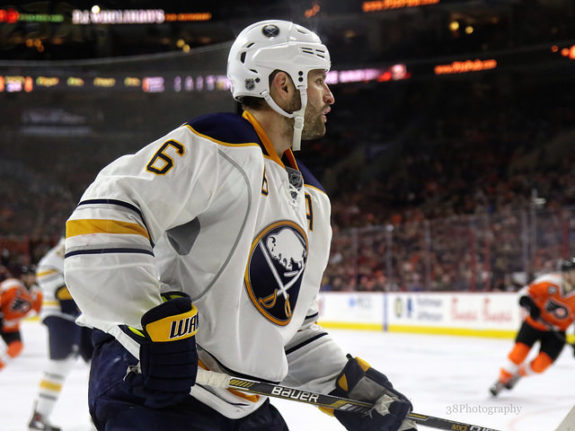
The forward ranks are very sad as well. Outside of primo piece Dylan Cozens, there isn’t much to get excited about. That includes Casey Mittelstadt and Tage Thompson, the player they acquired by trading the piece they so desperately need now.
This season’s crop of prospects available in the top-10, especially in the forward ranks, are particularly enticing. Lucas Raymond, Alexander Holtz, Anton Lundell, Marco Rossi, Cole Perfetti and a host of others would provide the Sabres with a bonafide prospect in the pipeline capable of filling the net and easing the burden placed on Jack Eichel.
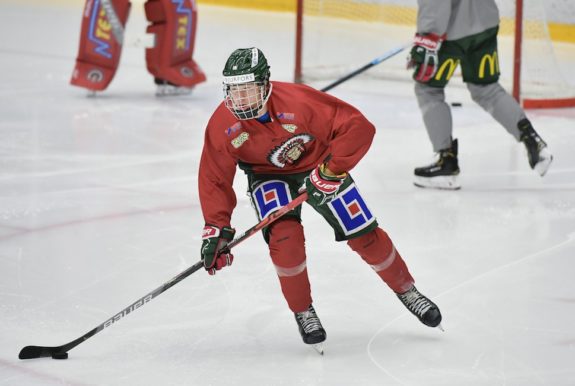
The nature of their contracts makes them a seemingly simple add. When they join the roster – likely for the 2021-22 season – they will cost the Sabres less than $1 million on the salary cap before bonuses. If you strike it right and cash in on the player’s entry-level contract, you can have a major contributor to playoff runs at a significant discount.
And that discount will matter. While the Sabres have a great degree of flexibility this offseason, they will still have to give significant deals to Sam Reinhart, Victor Olofsson and Brandon Montour this season while next season will see Henri Jokiharju and ultra-phenom Rasmus Dahlin require new contracts. Every penny will count, and having a steady wave of talented prospects will be essential.
Given all that is on the line for the franchise, staying where they are and making the pick looks like a slam dunk at first blush. Looking deeper, though, lends itself to the thought that trading the pick – although it might feel wrong – is the way to go.
Why Trading the First-Rounder Makes Sense
All of the above points are completely valid. The Sabres need cheap talent desperately and the draft is often the best way to do it. But with the climate in Sabreland where it currently sits, the time is now to get creative with a major asset.
Firstly, picking in the top-10 can be a crapshoot, even more so the further away you fall from the first pick. The Sabres are a living, breathing example of this. They’ve picked in the top-eight each of the last seven drafts and will pick no worse than tenth this season. Where has it gotten them? Really, not much further than when they tanked for Eichel.
Related: Best Undrafted Players in NHL History
If the Sabres were to retain their current draft position, they would pick seventh. Over the last 10 drafts, here are the players that were selected seventh: Jeff Skinner, Mark Scheifele, Matt Dumba, Darnell Nurse, Haydn Fleury, Ivan Provorov, Clayton Keller, Lias Andersson, Quinn Hughes and Dylan Cozens.

To be sure, there are some nice picks in there. The thought of adding a Scheifele, Hughes or (another) Skinner is enticing. The worry is that your pick is the next Fleury or Andersson. In reality, most of this list outside of Scheifele, Skinner and Hughes isn’t really what the Sabres need right now. And in fact, they probably won’t even help next season. Most players picked in this range tend to need at least one more season in junior to prepare.
For teams that are usually playoff contenders but struggled this season due to injuries or other circumstances like the Winnipeg Jets or Minnesota Wild, dipping this deep into the well of the draft may not happen often and they should make their picks.
The Sabres’ track record of picks in this range has not been strong though. They practically own the well at this point and have little to show for it. Running the risk of squandering another promising asset now just isn’t worth the effort. Let someone else make the pick and incubate it, hoping it hatches into something useful. In the meantime, use this asset to complete your roster.
If the Sabres bring back Johan Larsson and Zemgus Girgensons, they’d have a complete top line, a competent third line and a solid fourth line. Meanwhile, Skinner would be the “Will Smith looking around the empty room.gif” on the second line. They desperately need a centre and right-winger for Skinner. This pick is their only shot at that.
Too Valuable Not to Trade
When you have needs as glaring as the Sabres do, trading can be difficult. The holes you’re looking to fill are at critical points in your lineup. You aren’t looking for a depth defenceman or a nice complementary piece for your bottom-six. You are trying to bring in big-money pieces, players that are the backbone of an organization’s success. Nearly every team in this league would love to add two top-six forwards.

That being the case, the cost is very high. What exactly do the Sabres have in terms of currency to acquire what they need?
In the forward ranks, there is really nothing that they could afford to part ways with that would bring them what they need. Everyone who is brought in for next season will be an essential piece or not valuable enough.
The goaltending ranks are pretty barren, too. I’m sure the Sabres would be open to trading either Carter Hutton or Linus Ullmark if it meant they could get a talent for the top-six. Heck, I’d drive them to the airport myself. The reality is, the only top-six forward they would bring you would be of the AHL variety.
That brings us to the Sabres area of greatest strength, the defence. Dahlin and Jokiharju should be non-starters in trade talks. One name has been bandied about as a trade chip for a few seasons now and is still here. That name? Rasmus Ristolainen. No one else in the NHL has had more trade talk around them over the last three seasons without being moved.
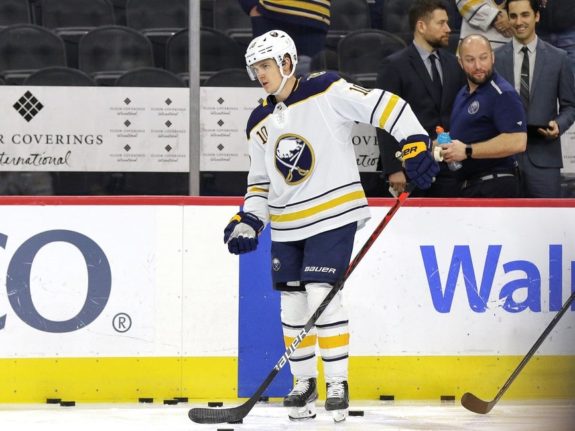
What makes him attractive as a defensive asset is his big body, his physical play and his ability to block pucks. What makes him less attractive is the fact that he has to use his big body to play physical and block pucks so often. His defensive lapses have continued to pile up and the underlying numbers are less than flattering.
Trading Ristolainen made a lot of sense two seasons ago. At that point, he was still the number one defenceman on the Sabres and got all of the prime deployment on the power play. His underlying numbers were often dismissed because he was on such poor teams. What’s becoming more obvious now is that he was part of the reason those teams were so bad.
Attempting to move him now would be like trying to go into your local video game store and exchanging your copy of NHL 17. It was a fun game. You used it a lot and have a lot of memories. What kind of value will you be getting for it now though? Outside of one or two people who feel nostalgic about the game or just really loved the soundtrack, you either keep it forever or trade it for a city bus simulation game.
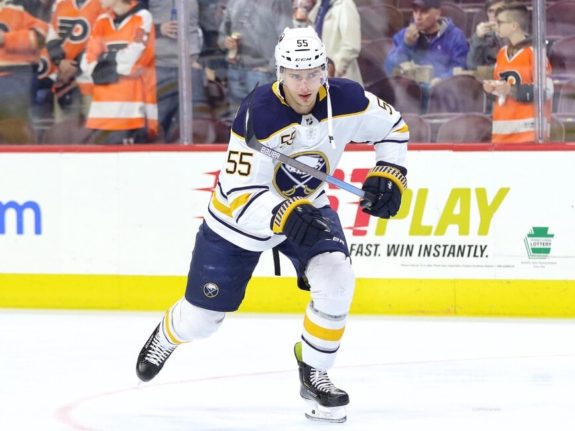
Ristolainen no doubt still has some believers out there but they are few and far between and not likely to give you as much as you were hoping for. In all likelihood, the Sabres missed the boat on him.
Jake McCabe is another asset that has an NHL 17-vibe to him. His value is pretty low. Colin Miller, Brandon Montour and Lawrence Pilut feel like they were NHL 19 but weren’t used properly when you brought them home and now they have some scratches (pun absolutely intended).
After this thorough investigation, it seems pretty obvious that the only real asset with any value that can be traded is the pick. It may hurt to do so and it’s not without risk, but the pick should definitely be moved for help in the top-six.
Trading the Pick a Tough Decision
Making or trading the pick is definitely not an easy choice. Either option requires a degree of skill and precision in addition to a leap of faith. Whether or not Jason Botterill is the right man for the job who knows? The bottom line is a decision needs to be made.
Making the pick is the safe route. Very few top-10 selections get traded each season. If the player pans out, great. If not, that’s just “the draft”.
Trading the pick brings its share of skepticism. From the moment it’s moved, the pick and the primary return will always be compared. If the return isn’t enough, the offending GM puts himself at a much higher risk of losing his job. If it does work, however, a franchise can be put on a completely different trajectory.
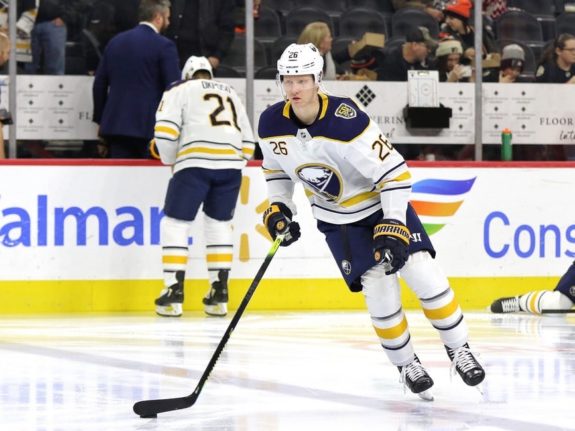
Sabres fans may not really see the value of such a high pick. Their team has used so many of them and gotten so little. But for teams that have been contending for years and now see their window closing, the prospect of such a pick can be all too alluring. If they have consistently been picking after 15 and now see their team falling apart, adding a top-10 pick can save a GM’s job or help him really put a stamp on his new one.
It takes a savvy GM to unearth these opportunities and expose them. Keep digging. Find that desperate colleague who needs to save his job or eager beaver looking to make his mark on the league. Find that value and extract it. Staying the course and playing it safe hasn’t gotten the Sabres anywhere yet. Delaying relevancy any longer runs the risk of wasting the entry-level contracts of Eichel, Reinhart, Mittelstadt, Dahlin and Cozens.
It’s time to take the plunge and turn the Good Ship Sabre around.